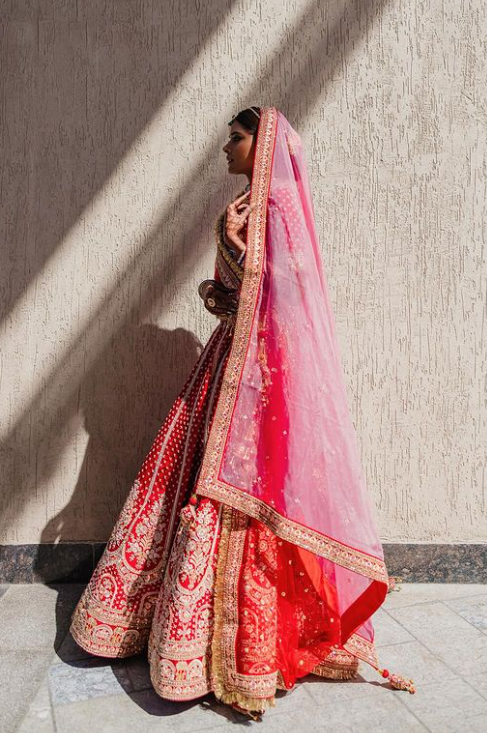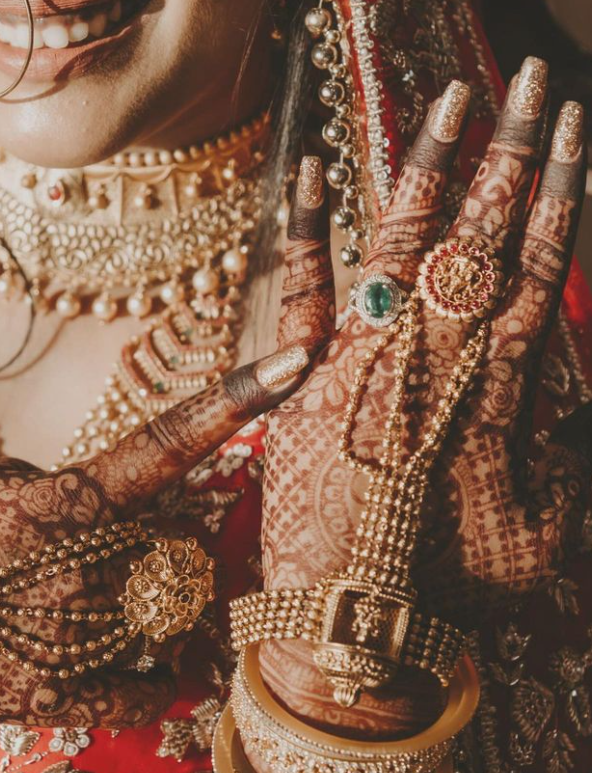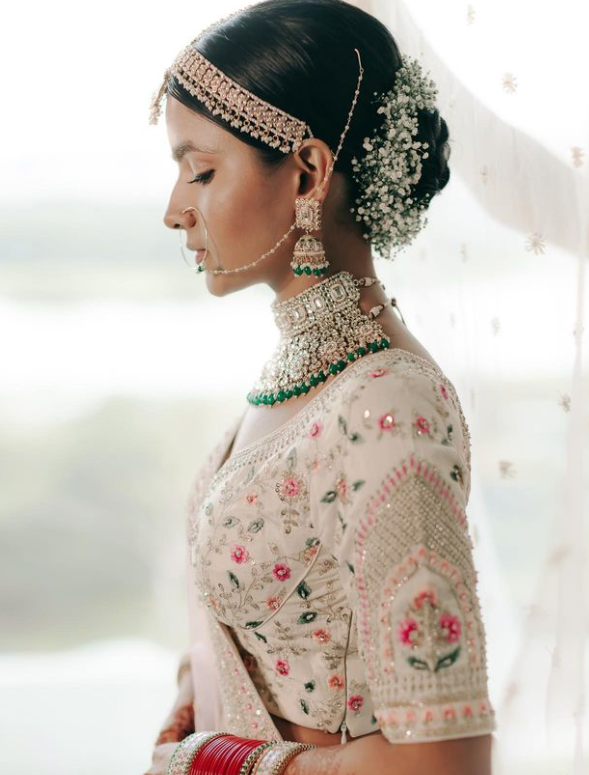
Introduction
The journey of an Indian bride is a fascinating blend of tradition, culture, and elegance. It’s more than just the wedding day—it’s a series of rich rituals and customs that have been passed down through generations. An Indian bride is the epitome of grace, beauty, and cultural heritage, symbolizing the union of two families and the start of a new chapter in life.
Table of Contents
The Traditional Attire

Bridal Saree
One of the most iconic elements of an Indian bride’s ensemble is the bridal saree. This elegant garment, usually six to nine yards in length, is draped in various styles across different regions.
- Types of Sarees: From the Banarasi silk saree of North India to the Kanjeevaram saree of South India, each type boasts intricate designs and rich fabrics.
- Regional Variations: The draping style and fabric choice vary greatly across India. For instance, a Bengali bride might wear a red and white saree, while a Maharashtrian bride might choose a green Paithani saree.
Lehenga Choli

In addition to sarees, many Indian brides opt for a lehenga choli, especially in North India.
- Description and Components: A lehenga choli consists of a long skirt (lehenga), a fitted blouse (choli), and a dupatta (scarf). The ensemble is often heavily embroidered with gold and silver thread.
- Popular Designs and Trends: From traditional zardozi work to contemporary sequins and crystals, lehengas come in a variety of styles to suit every bride’s taste.
Bridal Jewelry

Essential Pieces
Jewelry is an integral part of an Indian bride’s attire, with each piece holding its own significance.
- Necklace: Ranging from the choker-style to long, layered pieces, necklaces often feature intricate designs and precious stones.
- Earrings: Large, elaborate earrings that complement the necklace are a must.
- Maang Tikka: This forehead ornament symbolizes the bride’s marital status and is usually adorned with a central pendant.
Cultural Significance
Each piece of jewelry worn by an Indian bride is imbued with cultural and symbolic meaning, representing prosperity, fertility, and marital bliss.
Bridal Makeup and Hairstyling

Traditional Bridal Makeup
Indian bridal makeup is known for its bold and dramatic look.
- Typical Makeup Elements: Bright eyeshadow, thick eyeliner, and red or maroon lipstick are common.
- Products and Techniques Used: High-quality products and techniques like airbrush makeup are often employed to ensure a flawless finish.
Bridal Hairstyles
Hair is styled meticulously to enhance the bride’s overall look.
- Popular Traditional Hairstyles: From the classic bun adorned with flowers to intricate braids, the hairstyles are designed to complement the bride’s attire and jewelry.
- Accessories Used: Hair accessories like fresh flowers, jewelry pieces, and decorative pins add an extra touch of elegance.
Pre-Wedding Rituals
Haldi Ceremony
The Haldi ceremony is a pre-wedding ritual where a paste made of turmeric, sandalwood, and other ingredients is applied to the bride’s skin.
- Importance and Rituals Involved: This ceremony is believed to bless the bride and groom with prosperity and ward off evil spirits.
Mehndi Ceremony
The Mehndi ceremony involves applying intricate henna designs to the bride’s hands and feet.
- Significance and Designs: The mehndi is not just decorative; it’s believed to bring good luck and is an expression of joy and celebration.
Wedding Day Rituals
Kanyadaan
One of the most emotional moments of the wedding is the Kanyadaan, where the father gives away his daughter to the groom.
- Meaning and Process: This ritual signifies the handing over of responsibility and the acceptance of the bride into the groom’s family.
Varmala Ceremony
The Varmala or Jaimala ceremony involves the bride and groom exchanging flower garlands.
- Symbolism and Execution: This act symbolizes mutual respect and acceptance.
Saptapadi
The Saptapadi, or the seven steps, is a crucial ritual where the couple takes seven vows together.
- The Seven Vows and Their Significance: Each step and vow represents a promise to each other, covering aspects like companionship, health, and prosperity.
Post-Wedding Traditions
Vidaai
The Vidaai ceremony marks the bride’s departure from her parental home.
- Emotional Aspect and Traditions: It’s a poignant moment filled with mixed emotions as the bride bids farewell to her family.
Griha Pravesh
Upon arrival at her new home, the bride is welcomed with the Griha Pravesh ceremony.
- Welcoming the Bride to Her New Home: This ritual signifies the bride’s entry into her new family and her role as a wife and daughter-in-law.
The Role of Color in Indian Bridal Wear
Color plays a significant role in Indian bridal attire, with red being the most traditional and auspicious choice. However, modern brides are exploring a spectrum of colors, each with its own meaning and charm.
Regional Variations in Bridal Attire
North Indian Brides
North Indian bridal attire typically includes vibrant lehengas and heavy jewelry, reflecting the region’s rich cultural heritage.
South Indian Brides
South Indian brides often wear silk sarees with gold jewelry, showcasing the grandeur and elegance of Southern traditions.
The Evolution of Indian Bridal Fashion
Indian bridal fashion has evolved over the years, blending traditional elements with modern trends. Contemporary designers are reinterpreting classic styles, creating a fusion of the old and the new.
The Emotional Journey of an Indian Bride
The journey of an Indian bride is an emotional rollercoaster, filled with joy, anticipation, and sometimes, a bit of anxiety. Personal stories and experiences add depth to the understanding of this significant life event.
Conclusion
The Indian bride is a symbol of beauty, tradition, and cultural heritage. From the intricate rituals to the elaborate attire, every aspect of an Indian bride’s journey is a testament to the rich cultural tapestry of India. Embracing both tradition and modernity, the Indian bride continues to inspire awe and admiration.
FAQs
What is the significance of the bridal saree?
The bridal saree is a symbol of cultural heritage and tradition. It represents the bride’s identity and the rich history of Indian textiles.
How do Indian brides choose their jewelry?
Indian brides choose their jewelry based on cultural significance, family traditions, and personal preferences. Each piece is selected to complement the bridal attire and enhance the overall look.
What are the main rituals in an Indian wedding?
Main rituals include the Haldi ceremony, Mehndi ceremony, Kanyadaan, Varmala, Saptapadi, Vidaai, and Griha Pravesh. Each ritual has its own significance and cultural importance.
How has Indian bridal fashion evolved over the years?
Indian bridal fashion has evolved by incorporating modern trends while staying true to traditional elements. Designers blend classic styles with contemporary aesthetics to create unique bridal looks.
What are some regional differences in Indian bridal wear?
Regional differences in Indian bridal wear include variations in attire, jewelry, and rituals. For example, North Indian brides often wear lehengas, while South Indian brides typically choose silk sarees.
Explore our additional blogs and utilize our wedding budget planner tool for comprehensive wedding planning assistance.
A STEP-BY-STEP INDIAN WEDDING BUDGET PLANNER (TOOL) FOR YOUR INDIAN CELEBRATION
UNVEILING THE BEAUTY OF THE VARMALA CEREMONY: A SYMBOLIC UNION OF HEARTS
MEHNDI CEREMONY: BRIDAL BEAUTY AND TRADITION UNVEILED
EVERYTHING YOU NEED TO KNOW ABOUT THE SANGEET CEREMONY
HALDI CEREMONY: EMBRACING HERITAGE AND HAPPINESS ON THE PATH TO FOREVER



Pingback: Indian Wedding Trends 2024: What’s In and What’s Out - dulha dulhan daiaries
Pingback: Pre wedding shoot ideas india - dulha dulhan daiaries
Pingback: Top 10 Dreamy Indian Wedding Destinations for the Perfect Romantic Celebration - dulha dulhan daiaries
Pingback: Why Indian Weddings Are So Expensive - dulha dulhan daiaries